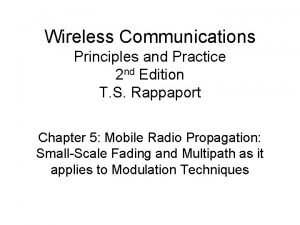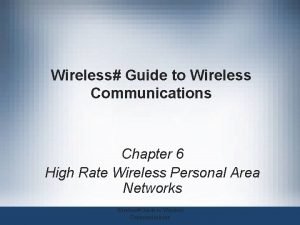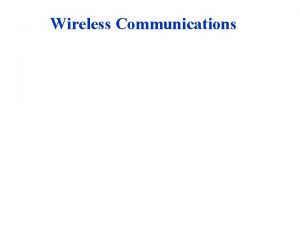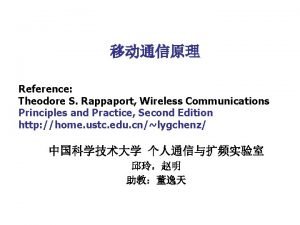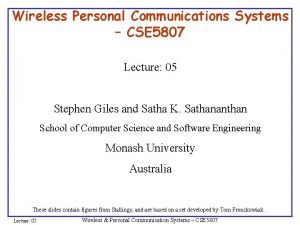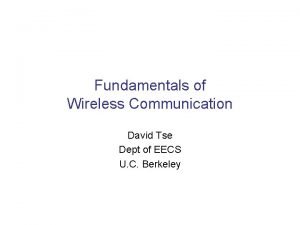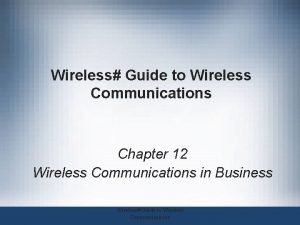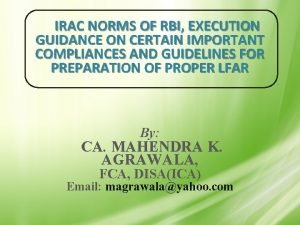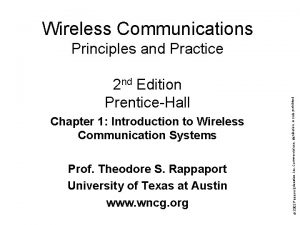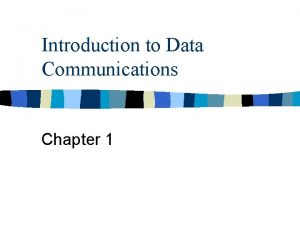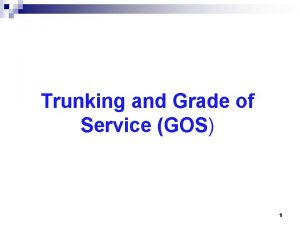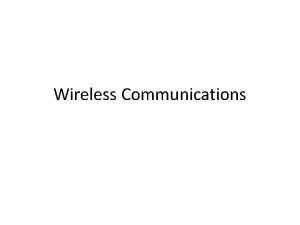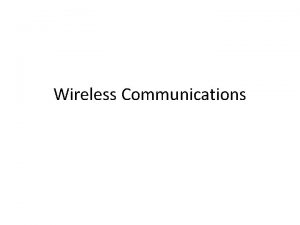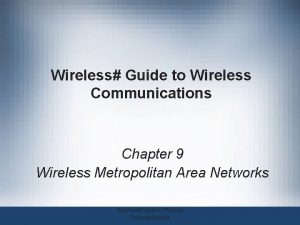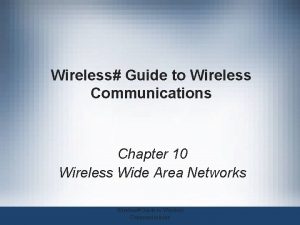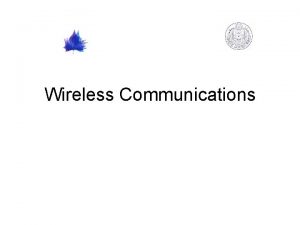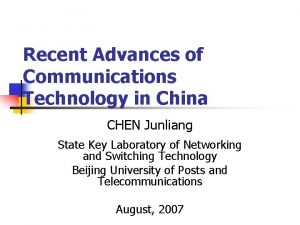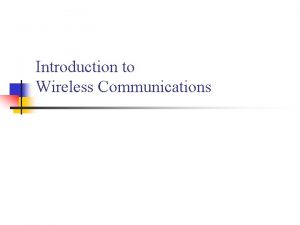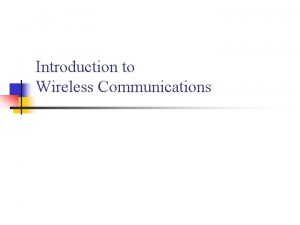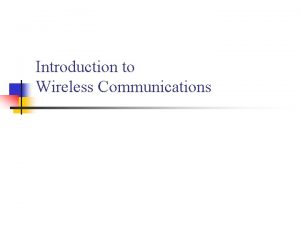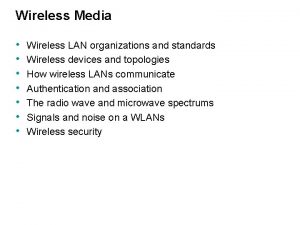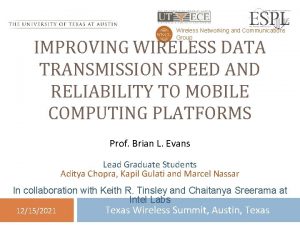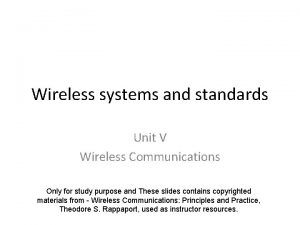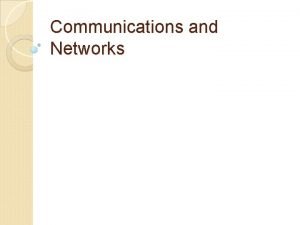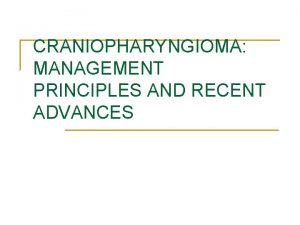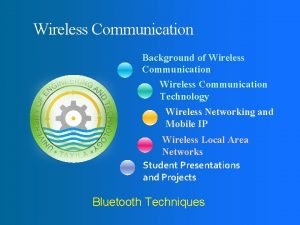Introduction to Wireless Communications and Recent Advances 1











































- Slides: 43

Introduction to Wireless Communications and Recent Advances 1

Outline q Some Basics on Communications q Current Wireless Systems q Recent Research Activities 2

Basic Elements of a Comm. System Information source Input transducer Transmitter Source encoder Channel encoder Modulator Noise Output message Output transducer Source decoder Channel Demodulator Receiver 3

Source Coding Source encoder maps the digital signal generated at the source output into another signal in digital form q The objective is to eliminate or reduce redundancy so as to provide an efficient representation of the source output q Source decoder simply performs the inverse mapping and thereby delivers to the user destination a reproduction of the original source output q q The primary benefit thus gained from the application of source coding is a reduced bandwidth requirement 4

Channel Coding Channel coding provides protection against transmission error. This is done by inserting redundant data in a prescribed fashion q Channel encoder inserts redundant information in a very selective manner. q Thus, in source coding, we remove redundancy, whereas in channel coding, we introduce controlled redundancy. q Channel coding plays an extremely important role in the system design q 5

Modulator Modulation is performed to transmit the signal efficiently over the channel q Converts digital data to a continuous waveform suitable for transmission over channel – usually a sinusoidal wave q Information is transmitted by varying one or more parameters of the transmitted signal or waveform: q Amplitude – AM, ASK, on/off keying n Frequency – FM, FSK n Phase – PM, PSK n 6

Transmission Protocols q Simplex n q Broadcast radio, TV Half Duplex n q Communication flow can only occur in one direction Communication flow can occur in both directions, but not at the same time Walkie-Talkies Full Duplex n Communication link can support simultaneous two -way communications, via TDD or FDD Telephone networks 7

Transmission Systems q Analog Communications The transmitter sends a waveform from an infinite variety of waveform shapes n The receiver is to reproduce the transmitted waveform with high fidelity, which is usually measured in terms of SNR n q Digital Communications 00011011110 Signals made up of discrete symbols selected from a finite set n Fidelity or Accuracy is specified in terms of bit error rate n 8

Wireless Radio Channel Radiation of electromagnetic energy to the propagation medium is done by an antenna q Antenna size and configuration depend on the operation frequency q 9

Radio Spectrum q The set of all frequencies from 0 Hz to infinity is known as the radio spectrum and is used for many different applications Frequency 30 -300 Hz SLF 300 -3 k. Hz ULF 3 k-30 k. Hz VLF 30 k-300 k. Hz LF 300 k-3 MHz MF 3 M-30 MHz HF 30 M-300 MHz VHF 300 M-3 GHz UHF 3 G-30 GHz SHF 30 G-300 GHz EHF Infrared 6000 GHz Light X-ray Gamma-ray Usage Broadcast AM Paging/TV/Broadcast FM Mobile phones / WLAN Radars Remote control Camera Medicine 10

Spectrum Regulation Radio waves travel or propagate through a common channel that everybody shares q That is for a particular frequency only one person, user or company can use it – otherwise there will be interference and chaos! q The government owns the radio spectrum and regulates it q n q Federal Communications Commission (FCC) in US Spectrum regulation must be coordinated globally by International Telecommunication Union (ITU) 11

Licensed Spectrum Allocation in US Service/system Frequency span AM radio 535 -1605 k. Hz FM radio 88 -108 MHz Broadcast TV 54 -88 MHz, 174 -216 MHz, 470 -806 MHz Broadband wireless 746 -764 MHz, 776 -794 MHz 3 G systems 1. 7 -1. 85 MHz, 2. 5 -2. 69 MHz 1 G and 2 G cellular phones 806 -902 MHz, 1. 85 -1. 99 GHz Satellite digital radio 2. 32 -2. 325 GHz Multichannel multipoint distribution service (MMDS) 2. 15 -2. 68 GHz Digital broadcast satellite (Satellite TV) 12. 2 -12. 7 GHz Local multipoint distribution service (LMDS) 27. 5 -29. 5 GHz, 31 -31. 3 GHz Fixed wireless services 38. 6 -40 GHz 12

Unlicensed Spectrum Allocation in US Band Frequency ISM band I (Cordless phones, 1 G WLAN) 902 -928 MHz ISM band II (Bluetooth, 802. 11 b/g WLAN 2. 4 -2. 4835 GHz U-NII band I (Indoor systems, 802. 11 a WLAN) 5. 15 -5. 25 GHz U-NII band II (short-range outdoor systems, 802. 11 a WLAN) 5. 25 -5. 35 GHz U-NII band II (Long-range outdoor systems, 802. 11 a WLAN) 5. 725 -5. 825 GHz 13

Radio Wave Propagation q A free-space propagation model n : transmitted power n : received power n : transmit antenna gain n : receive antenna gain : wavelength : transmit-receive distance 100 meters Receives 1/4 of the power 200 meters 14

Radio Wave Propagation q The reason for this is simple conservation of power q Total 200 m 100 m power input must equal total power output q Surface area of sphere is q Therefore as radius or distance increases total power on surface must decrease as inverse square distance 15

Multiple Access Techniques FDMA TDMA CDMA 16

Outline q Some Basics on Communications q Current Wireless Systems q Recent Research Activities 17

Current Wireless Systems q q q q Cellular Mobile Phone Systems Wireless LANs Satellite Systems Paging Systems Bluetooth Zig. Bee radios Ultra-wideband radios … 18

Evolution of Mobile Phone Systems q q First commercial mobile phone service in 1946 n Use a central transmitter to cover an entire metropolitan area Cellular concept in 1950 s & 1960 s at AT&T Bell Lab. n Cell splitting and frequency reuse BASE STATION Mobile Telephone Switching Office 19

Evolution of Mobile Phone Systems 20

Wireless Local Area Networks (WLANs) 01011011 0101 1011 Internet Access Point High-speed data communication within a small region q Client/server network or Ad-hoc network q Channel access is based on carrier-sense multiple access with collision avoidance (CSMA/CA) q Backbone Internet provides best-effort service q 21

Wireless LANs Standards Range (indoor (outdoor ) ) Operating Standard Throughput Frequency Max Raw Data Rate 802. 11 b 2. 4 GHz 4. 3 Mbps 11 Mbps 38 m 140 m 802. 11 a 5 GHz 23 Mbps 54 Mbps 35 m 120 m 802. 11 g 2. 4 GHz 19 Mbps 54 Mbps 38 m 140 m 2. 4 GHz, (new) 5 GHz 74 Mbps 248 Mbps 70 m 250 m 802. 11 n Many WLAN cards support 802. 11 a/b/g simultaneously 22

Bluetooth q Cable replacement for electronic devices (cell phones, laptops, PDAs, etc) Short range connection (10 ~ 100 m) q 1 Data (700 Kbps) and 3 voice channels (64 Kbps) q Use frequency hopping for multiple access, operate at 2. 4 G Hz band q Widely supported by telecommunications, PC, and consumer electronics companies q 23

IEEE 802. 15. 4 / Zig. Bee Radios q q q q Low-cost, low-power, low-rate Operate at ISM band Data rate up to 250 kbps at up to 30 m Star clusters or peer-to-peer operation CSMA-CA channel access Mainly to provide radio operation for months/years without recharging Target application: n Medical data collection, intruder warning, sensor networks, inventory tags 24

Ultrawideband (UWB) Radios q UWB is an impulse radio: sends pulses of tens of picoseconds(10 -12) to nanoseconds (10 -9) q A carrier is not necessarily needed q Extremely wideband radios (3. 1 -10. 6 GHz): Overlays existing users, but its allowed power level is very low to minimize interference q Very high potential date rate: 500 Mbps at 3 m q Small devices, low power consumption q Unique Location and Positioning properties: 1 cm accuracy 25

Data rate 100 Mbps 100 kbps UWB 802. 11 g 802. 11 b 3 G 802. 11 a Bluetooth Zig. Bee UWB 10 kbps 0 GHz 1 GHz 2 GHz 3 GHz 4 GHz 5 GHz 6 GHz 26

Range 10 km 3 G 1 km 100 m 10 m 802. 11 a 802. 11 b, g Zig. Bee UWB Bluetooth Zig. Bee UWB 1 m 0 GHz 1 GHz 2 GHz 3 GHz 4 GHz 5 GHz 6 GHz 27

Power dissipation 10 W 3 G 1 W 100 m. W 802. 11 bg Bluetooth 10 m. W Zig. Bee 802. 11 a UWB 1 m. W 0 GHz 1 GHz 2 GHz 3 GHz 4 GHz 5 GHz 6 GHz 28

Technical Challenges q System design Support of multi-mode operation n Cheap, small, lightweight, and low power n q Wireless channels Scarce and expensive radio spectrum n Time-varying environment n Security n q Network Connectivity and high speed n Energy and delay constraints n 29

Outline q Some Basics on Communications q Current Wireless Systems q Recent Research Activities 30

Recent Research Activities (since 1998) MIMO (multiple-input multiple-output) q Cooperative Communications q Cognitive Radio q 31

MIMO (multiple-input multiple-output) “multiple” refers to multiple antennas q MIMO is a revolutionary technology in wireless communications proposed in late 90’s q It opens up the spatial domain for information transmission q What can MIMO offer: Higher transmission rate n Higher link reliability n Wider coverage n 32

Fundamental Gains: Multiplexing Multiple antennas at both Tx and Rx q Can create multiple parallel channels q Multiplexing order = min(M, N), where M =Tx, N =Rx q Transmission rate increases linearly q Tx Rx Rx Tx Spatial Channel 1 Spatial Channel 2 33

Fundamental Gains: Diversity Multiple Tx or multiple Rx or both q Can create multiple independently faded branches q Diversity order = MN q q Link reliability can be improved exponentially Rx Tx Tx Rx Fading Channel 1 Fading Channel 2 Fading Channel 3 Fading Channel 4 34

Research Issues q How to design practical Space-Time (ST) coding and modulation techniques to achieve low error probability, high spectral efficiency, and with low complexity (mutually conflicting)? 35

Applications of MIMO Quickly established as a hot research area since the work Foschini’ 98 and Tarokh’ 98 q Still remains active q Have been adopted or proposed in many wireless standards q WLAN IEEE 802. 11 n Wi. MAX IEEE 802. 16 n 3 G n 4 G n 36

Cooperative Communications (CC) CC exploits MIMO principle among a collection of wireless terminals in a network -> Virtual MIMO [Sendonaris’ 03, Laneman’ 04] q What can cooperative comm. offer: q Increased coverage n Reduced transmission power n Cooperative diversity n q Applications Cellular systems n Wireless sensor networks n Wireless ad-hoc networks n 37

Research Issues for Cooperative Comm. q Capacity bound of relay channels q Distributed channel coding with cooperative diversity q Relay Selection q Cooperative MAC layer protocols 38

A Scenario: Wireless Multi-hop Cellular Networks q q Relay naturally leads to multi-hop transmission Resource allocation is the key problem 39

Cognitive Radio (CR) q Definition (Haykin’ 03): Cognitive radio is a wireless architecture in which a communication system is capable of n sensing the spectrum environment and adapting its transmission parameters (e. g. transmit power, carrier frequencies, and modulation formats) to efficiently utilize the radio resources. Cognitive radio promises high spectral efficiencies by using under-utilized parts of licensed bands q Unlicensed devices should not obstruct the privileges of licensed ones q WRAN IEEE 802. 22 standard proposed for TV bands q 40

Research Issues for Cognitive Radio q Spectrum sensing and prediction q Dynamic spectrum access q Adaptive power control 41

Conclusion Wireless communications is fastest growing segment of communication industry q The wireless vision encompasses many exciting systems and applications q Exciting research topics remain open q MIMO n Cooperative communication n Cognitive radio n 42

43
 Recent advances in ceramics
Recent advances in ceramics Telecommunications the internet and wireless technology
Telecommunications the internet and wireless technology Sircim
Sircim Wpan security
Wpan security Constrained nodes and constrained networks
Constrained nodes and constrained networks Subsea wireless communications
Subsea wireless communications Theodore s rappaport wireless communications
Theodore s rappaport wireless communications Cse
Cse Fundamental of wireless communication
Fundamental of wireless communication Guide to wireless communications
Guide to wireless communications Taly payroll
Taly payroll Short term loans and advances
Short term loans and advances Global oncology trends 2017 advances complexity and cost
Global oncology trends 2017 advances complexity and cost Chapter 17 section 2 the axis advances
Chapter 17 section 2 the axis advances Advances in technology during wwii
Advances in technology during wwii Chapter 9 intellectual development in the first year
Chapter 9 intellectual development in the first year Advances in real time rendering
Advances in real time rendering Photodesintegration
Photodesintegration Opto-electronic advances
Opto-electronic advances Irac circular rbi
Irac circular rbi Advances in memory technology
Advances in memory technology Introduction to data communications and networking
Introduction to data communications and networking Wireless communication introduction
Wireless communication introduction Introduction of wireless power transmission
Introduction of wireless power transmission Introduction to data communications
Introduction to data communications Recent trends in ic engine
Recent trends in ic engine Recent developments in ict
Recent developments in ict Recent developments in object detection
Recent developments in object detection Ap synthesis prompt
Ap synthesis prompt Explain recent trends in foreign trade of india
Explain recent trends in foreign trade of india Skimming and scanning examples
Skimming and scanning examples Current trends in project management
Current trends in project management Recent demographic changes in the uk
Recent demographic changes in the uk Myipsclever
Myipsclever Stippling
Stippling Jose has just played a long bruising football game
Jose has just played a long bruising football game A friend emails you the results of a recent high school
A friend emails you the results of a recent high school Passive voice in news reports
Passive voice in news reports Https drive google com drive u 0 recent
Https drive google com drive u 0 recent Recent amendments in companies act
Recent amendments in companies act Mis trends
Mis trends Mpgu
Mpgu Advantages and disadvantages of wired and wireless networks
Advantages and disadvantages of wired and wireless networks Trunking and grade of service in wireless communication
Trunking and grade of service in wireless communication


